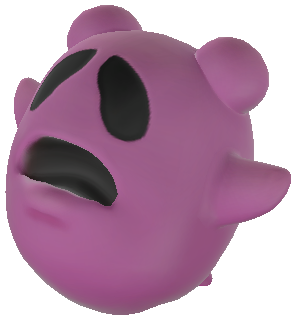The Triforce Wielders Recurring: Goddesses and Allies, Villains and Enemies, Races Main Series: The Legend of Zelda, Zelda II: The Adventure of Link, A Link to the Past, Link's Awakening, Ocarina of Time, Majora's Mask, Oracle games, Four Swords, The Wind Waker, Four Swords Adventures, The Minish Cap, Twilight Princess, Phantom Hourglass, Spirit Tracks, Skyward Sword, A Link Between Worlds, Tri Force Heroes, Breath of the Wild & Tears of the Kingdom Spin-Offs: Philips CD-i Games, Hyrule Warriors, Cadence of Hyrule, Hyrule Warriors: Age of Calamity
This is the list of all characters in The Legend of Zelda: Link's Awakening. BEWARE OF UNMARKED SPOILERS!
Link and His Allies

- Adaptational Angst Upgrade: In the manga, he is horrified once he realizes that his mission to wake the Wind Fish will remove Koholint Island from existence. He frantically attempts to avoid finishing his quest, even trying to ride away together with Marin on a boat before being deterred by an invisible force back to the island, before the owl finally convinces him he can't fight fate.
- Adaptational Jerkass: In the manga, Link is slightly immature, hotheaded and rude as he's not above being a bit abrasive to his Fairy Companion, Felicia but as he spend times on Koholint Island, befriends Marin and Tarin, exploring the dungeons and helping them together, he mellows out into a mature and nice person.
- Adaptational Modesty: Downplayed in the Switch remake. He wears the white tights from the Oracle games as part of his outfit, whereas he originally didn't and went bare-legged (like in A Link to the Past) according to the artwork for the Game Boy/Game Boy Color versions.
- And the Adventure Continues: After Koholint Island disappears, he is last seen in the ocean with the remains of his ship.
- Closed Circle: Link cannot return home until he awakens the Wind Fish.
- Did Not Get the Girl: Even if you get the perfect ending, Link will be unable to stay alongside Marin, since she escapes the dream reborn as a bird.
- The Dreaded: Link becomes this to the Nightmares, as they rightly fear he has the strength and courage to eventually wake the Wind Fish.
- Experienced Protagonist: He is the same Link as in A Link to the Past and potentially the Oracle games (Hyrule Historia states that it's the same Link in all of these, but the Encyclopedia says it's a different one in the Oracle games).
- Face Your Fears: The Final Boss takes the form of some of Link's greatest fears, including Ganon himself.
- Going Down with the Ship: Though his death is averted, thanks to Link tying himself to the ship's mast.
- Good Feels Good: He is able to pull himself out of his Heroic BSoD at the end upon realizing that the Wind Fish has been saved.
- Heroic BSoD: Upon waking up after destroying Koholint, Link sits slumped over on his raft, staring into the water in sadness.
- Hidden Depths: If the Final Boss is anything to go by, it seems Link is still afraid of Agahnim and especially Ganon after the events of A Link to the Past.
- Hyperactive Metabolism: In the Switch remake, Link can ram the apples out of a tree to eat them and regain health.
- Journey to Find Oneself: After his previous adventure, Link has long defeated the evil Ganon, but Hyrule merely enjoyed a cautious peace, its citizens wondering when the next threat would arrive to end the tranquility. Feeling in need of enlightenment, he embarks on this journey for foreign lands.
- Kleptomaniac Hero: In addition to Link's usual kleptomania, he can now outright steal things from the shop.
- Luminescent Blush: In the Switch remake, Link blushes (in apparent embarrassment, judging by his expression) when Madame MeowMeow kisses him after returning BowWow.
- My God, What Have I Done?: Source material like Hyrule Historia implies that Link has this reaction after watching Koholint island disappear after the Wind Fish woke up. His saddened expression after awakening at the end of the game reinforces this.
- Pyrrhic Victory: He successfully defeats the Nightmares, saves the Wind Fish, and escapes from Koholint Island, at the cost of the island itself and all of its inhabitants, including Marin.
- Shoot the Dog: In the end, Link has to destroy Koholint Island and all of its inhabitants (possibly including Marin) in order to save the Wind Fish and return to protecting Hyrule.
- Suddenly Speaking: The only time he speaks during the game is once he discovers the truth of Koholint.
- There's No Place Like Home: More than anything, Link dearly wishes to return to his beloved homeland, Hyrule.
- Tragic Hero: By the end of the game, Link has to choose whether to stay on Koholint with Marin, or return to Hyrule and continue protecting his kingdom. Doing the former will result in the Nightmares continuing to ravage the Wind Fish's dream and could lead to Ganon's return without a hero to stop him, but doing the latter will result in the destruction of the island and all of its inhabitants. He chooses the latter and awakens successfully, yet is highly remorseful for doing so.
- Unwitting Instigator of Doom: To the monsters/nightmares, he's this. Link doesn't even know the true nature of Koholint, yet they fear him all the same, knowing his desire to go home will be their undoing.
- Waking Up Elsewhere: Link goes unconscious after the lightning bolt hits his ship at the beginning. He wakes up in Marin and Tarin's house on Koholint Island.
- Wham Line: The only time he speaks in the game (and the only time this version of Link speaks at all) is when he realizes that, to his horror, Koholint Island is just a dream.Link: What...? Illusion?
- Your Mind Makes It Real: If Link dies in the Dream Shrine (which is a mini-dungeon that can only be accessed by dreaming oneself into it in a specific bed), the player gets a Game Over as normal instead of simply waking up back on Koholint. His conscience has also been pulled into the imagination of the Wind Fish, meaning if he dies in there, he can't reunite with his body in the real world.

The game's female lead, and a Suspiciously Similar Substitute to Princess Zelda. She has a differing personality, however; she's somewhat spunky and likes to spend her time outdoors, singing to the local animals. She rescues Link when he washes ashore from his shipwreck, and later teaches him the "Ballad of the Wind Fish", which is critical to waking the Wind Fish.
- And You Were There: She's supposed to be based somewhat on Zelda, enough that Link confused her for Zelda at first.
- Animorphism: In the DX and Switch versions of the game, Marin's wish to become a seagull is granted if the player manages to complete the game without dying, allowing her to escape the dream after the Wind Fish wakes. In the original Game Boy release, she became a Winged Humanoid instead.
- Beautiful Singing Voice: She's noted to be an excellent singer, and several characters praise her voice at one point or another. It's so good, in fact, that the entire Animal Village drops what they're doing to listen to her sing. This even becomes a plot point when Marin accompanies you there to wake up a particularly stubborn sleeping walrus.
- But You Were There, and You, and You: Inverted, as Malon who appears in later games is based on her. Is a straight version in Hyrule Historia's version of the timeline, which implies that she's based on Link's memories of the version of Malon who appeared in Oracle of Seasons.
- Calling Parents by Their Name: She calls her father "Tarin."
- Cannot Spit It Out: She clearly has romantic feelings for Link, but just isn't able to voice them.
- Deuteragonist: She gets the most development out of character in the game and is Link's strongest connection to Koholint Island.
- Fantastic Romance: Starts off as innocently as this. The Hero is Trapped in Another World and then gets embroiled in romance. However, after discovering all Koholint is but a dream, the player makes the disturbing realization that Marin isn't real at all, she's just the product of the Wind Fish's own psyche.
- Florence Nightingale Effect: This is how the game begins.
- Friend to All Living Things: She sings for the animals in the Animal Village, and scolds you if you attack Cuccos. However, she is scarily encouraging of Link abusing Cuccos if you do it for long enough. Probably because, once she starts encouraging you, if you keep doing it, the Cuccos will start attacking you like they usually do.
- Game-Breaking Bug: She was the subject of one in the Switch version of the game, in which she became stuck inside of her house during the game's prologue and stayed there through the rest of the story. Until it was patched, this made it impossible to advance past the Animal Village without her help or to learn the Ballad of the Wind Fish from her.
- Girl Next Door: She plays this role to Link throughout the story, even though he's only just arrived on Koholint.
- Girl of My Dreams: She exists only in the Wind Fish's dreams.
- Guest-Star Party Member: At one point, you are required to take Marin with you to wake up a walrus in order to continue with the main quest.
- Identical Stranger: Link, upon first meeting her, mistakes her for Princess Zelda.
- Informed Attribute: According to the game's manual and her Super Smash Bros. Melee trophy, Marin is supposedly a skilled harpist, despite this never being shown or alluded to in any of her in-game appearances.
- Ironic Fear: It's more of an ironic wish that she has considering her fear, but her greatest desire is to be able to leave the island and fly across the sea, and she even does so in the secret ending, despite acknowledging at one point that she's terrified of heights.
- I Want My Beloved to Be Happy: She's well aware that Link's quest will lead to him leaving the island, and her, behind, but she supports him doing so anyway and even attempts to wake the Wind Fish herself at one point.
- Manic Pixie Dream Girl: Apart from the fact that she literally is a "dream girl", she qualifies. Her life suddenly revolves around the protagonist, and she has a quirky personality. Of course, Link doesn't need convincing to be adventurous.
- Meaningful Name: She's a double case of this, depending on how you translate it. In French, Marin means "queen of the sea", hinting at her being a personification of the Wind Fish. However, in Hebrew, it means "sea of sorrow".
- Missing Mom: If she has a mother, she's never seen or mentioned.
- Nice Girl: She's sweet, kind and all-loving, even towards animals; she even calls Link out if he attacks Cuccos. She also rescues a stranded Link on Koholint and, once he gets a hold of himself (and his sword), she quickly tries to befriend him.
- Not So Above It All: She's a nice girl and often calls Link out when attacking animals or messing with people's pots and drawers, but there are moments when she displays an uncharacteristically quirky side... though it often dips into a more sinister and/or bloodthirsty one should Link meet certain criteria. This is referenced in Hyrule Warriors, as well.Marin: (if Link digs with the shovel) Great! Dig it! Dig it! Dig to the center of the earth!!
Marin: (if Link plays the ocarina without knowing any songs) Not very good... eh? What? Did I say something? No, you're hearing things...
Marin: (occasionally if Link breaks a pot) Yes! Yes! Break them! Break them all! ... ... ... ... What? What's wrong?
Marin: (if Link attacks a Cucco too many times) Ha ha ha! Do it! Do it! Do it moooore...! ... ... Hunh? No, it's nothing... I didn't mean it. - Outdoorsy Gal: No kidding. The only time she's seen indoors is in the beginning of the game, where she's watching over the unconscious Link. At one point, she even questions why her father would stay inside during the day when he could be outdoors. To be fair, he'd spent the night gallivanting as a raccoon. When she's traveling with Link, she waits outside for him whenever he goes into a dungeon, refusing to go in. Oh, and she wants to be able to leave Koholint and see the world when nobody else cares. Now that's outdoorsy.
- Real After All: The true ending implies that Marin either escaped the dream world, or may not have been a dream to begin with. The latter is hinted in her conversation with Link, as she's the only person who seems to know that a world exists beyond Koholint Island.
- Ship Tease: Link basically takes Marin on a date at one point in the game.You got Marin! Is this your big chance?
- Sky Face: In the Game Boy Color and Switch versions, Marin's face appears in the sky at the end if you managed to beat the game without dying.
- Tareme Eyes: Present in official art for her, and in the remake's secret ending
 ◊; they highlight her soft and nice nature.
◊; they highlight her soft and nice nature. - Temporary Substitute: Fills in for Princess Zelda in one of the only two games in the main series where Zelda doesn't appear at all.
- The Ugly Guy's Hot Daughter: A trait that carries on in later games with Malon.
- Ur-Example: She's the first example of a female lead who isn't Zelda and her Friend to All Living Things and The Ugly Guy's Hot Daughter aspect are typically carried through to future examples.
- Winged Humanoid: In the original Game Boy release of Link's Awakening, completing the game without dying would cause Marin to escape the dream as a human girl with wings. The DX and Switch remakes both changed this so that she becomes a seagull instead.

An owl that appears when Link clears a dungeon and tells him where to go next.
- Big Good: He's the one guiding and advising Link through Koholint Island and is also the guardian of the Wind Fish's dream.
- But You Were There, and You, and You: Inverted, Kaepora Gaebora who appears in later games is based on him.
- Exact Words: After Link visits the Southern Face Shrine and discovers the truth about the island, the Owl doesn't outright deny it, but also doesn't confirm it, and tells Link to continue on his quest and discover it for himself.Owl: Just as you cannot know if a chest holds treasure until you open it, so you cannot tell if this is a dream until you awaken… The only one who knows for sure is the Wind Fish… Trust your feelings… Someday you will know for sure…
- Face Death with Dignity: After DethI's defeat, the Owl visits Link one last time. He reveals his true purpose as the guardian of the Wind Fish's dreams and sincerely thanks Link for his help, before vanishing along with the rest of the island as Link and the Wind Fish awaken.
- Mr. Exposition: He appears several times to give Link hints about where he should go next.
- How the Mighty Have Fallen: He's supposed to be the guardian of the Wind Fish's dreams, essentially making him second-in-command as far as the island residents are concerned. But the nightmares have hijacked the dream, leaving him unable to do anything but observe. It’s been going on for so long he couldn't even tell if Link was real from a first glance.
- Manipulative Bastard: The Owl uses Exact Words and outright lies to hide the truth that Koholint Island is All Just a Dream in order to keep Link moving forward and ease his conscience.
- Nice Guy: Despite his dubious methods, the Owl is nothing but polite and grateful to Link for his help.
- No Name Given: People often mistakenly refer to him as Kaepora Gaebora since Kaepora Gaebora is an extremely obvious Suspiciously Similar Substitute of him, but this owl was never actually named.
- Pieces of God: At the end, the owl reveals he is part of the Wind Fish's spirit and guardian of his dreams.
- The Owl-Knowing One: He knows the true nature of the island.
- Unreliable Expositor: Once Link reads the inscription that warns that the Wind Fish awakening will mean the end of Koholint Island and its inhabitants, he suggests to Link that it might not be telling the entire truth. The end, however, reveals that it was a lie he told Link to ensure that he would complete his quest.
- Walking Spoiler: It's hard to discuss the Owl without revealing that he's part of the Wind Fish's mind and has been using Link to awaken his creator.
- The Watcher: He follows above Link for most of the adventure, frequently swooping down to talk with him. It's eventually revealed that he's part of the Wind Fish's consciousness that's pushing Link to wake him up.
- Well-Intentioned Extremist: The Owl lies to and manipulates Link in order to awaken the Wind Fish. This will result in a Dream Apocalypse that will wipe out the island, but it will also ensure that his creator, the Wind Fish, is rescued and Link will be able to return home.

Marin's father, who collects mushrooms.
- Animorphism: At one point, he's turned into a Raccoon (or Tanuki in the original Japanese version). Once he's back to normal, he recalls having fun as a raccoon, though he thinks it was All Just a Dream.
- Bumbling Dad: He's Marin's dad, and frequently gets himself into troubling situations like being turned into a raccoon or chased around by bees.
- But You Were There, and You, and You: Inverted, Talon who appears in later games is based on him.
- He's also reminiscent of Link's uncle from A Link to the Past. Link even obtains the first shield from him just like he did from his uncle in the previous game.
- Expy: Of Mario. He has the mustache, he loves eating mushrooms, and he's turned into a raccoon/tanuki. The resemblance to Mario carries over into Talon.
- Forced Transformation: He's turned into a raccoon by the magic mushroom. He later remembers it as a dream and comments that "it sure was fun!"
- Funetik Aksent: Downplayed, as he has a bit of an accent implied by the spelling of his dialogue, such as dropping Gs from words ending with "-ing", and pronouncing "can" and "to" as "kin" and "ta".
- Go Out with a Smile: Happily lifts a mushroom into the air as Koholint Island disappears.
- Moment Killer: He does this a couple of times during the game. In particular, he interrupts a very tender moment between Link and Marin towards the end of the game.
- Nice Guy: Despite his goofiness, he's about as friendly and cheerful as you'd expect a Mario Expy to be.
- Papa Wolf: When Marin goes missing in the Tal Tal Mountain Range late in the game, Tarin climbs to the top in search of her.
- Sleepy Head: Will be found at home napping in-between his appearances around the island.
- Trademark Favorite Food: Mushrooms. He often goes to pick them in the Mysterious Woods, with one turning him into a raccoon.
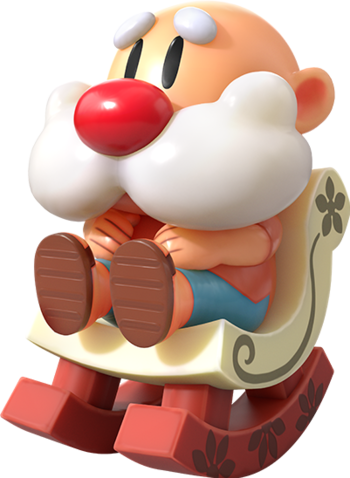
- Captain Obvious: "In the southeast of the island, you will find something called the Angler Key. Hmmm… How much more obvious do I have to be? Bye!"
- Hint System: When called on the phone, he will give Link advice on how to advance his quest.
- No Indoor Voice: In sharp contrast to her shy and quiet husband, Grandma Yahoo greets link with "YAHOO!"
- Serious Business: His wife wishes to sweep the whole island. Halfway through the game she's swept all the way to Animal Village.
- Situational Sociability: Ulrira is your source of advice on where to go next when you get stuck. You can call him from any phone and get his help. If you find him and speak to him in person, he'll barely speak to you. The best you can get out of him is a request to call him on the phone.
-
 The Walrus Was Paul: Just who is this "Bucket Mouse" you call if you use the phone in his house? Evidently, it's a mangling of a Japanese fishing shop called "Bucketmouth"
The Walrus Was Paul: Just who is this "Bucket Mouse" you call if you use the phone in his house? Evidently, it's a mangling of a Japanese fishing shop called "Bucketmouth" , but it's still pretty random.
, but it's still pretty random. - Writing Around Trademarks: Thanks to Yahoo!, many of Ulrira's shouts of "YAHOO!" had to be rewritten as "YIPPEE!" or "HELLO!"

The guardian deity that sleeps inside the giant egg at the center of Koholint Island.
- Adaptational Angst Upgrade: Doubles as Adaptational Sympathy. In the Switch remake, the pained sound of whale vocalizations play in the background of the Wind Fish's Egg, underlining the fact that the sleep he's in is troubled by fear and nightmares and making it more understandable why he desires to wake up from it.
- Antiquated Linguistics: The Wind Fish uses some antiquated words like "dost" and "thou" when speaking to Link in the ending.
- Blessed with Suck: Has the uncanny ability to make his dreams into reality. Unfortunately, this only lasts as long as he's asleep; once he's awake, nothing. More unfortunately, this also applies to his nightmares, and they eventually become powerful enough to take over the dream and make him sleep for good.
- Fisher King: Both the inhabitants of the island and the Nightmares are born from his dreams.
- Heavy Sleeper: Will never wake until Link recovers the eight Instruments of the Siren, and if Link doesn't wake him the stranded Hyrulian can never go home.
- Interspecies Friendship: Views humans and animals as equals, both given sapience and their villages are considered 'twin cities' in the idyllic tropical paradise, which makes perfect sense because he's a god.
- Journey to the Center of the Mind: All of Koholint is but his dream, and Link must travel his way to the center of an egg and awaken the core of the deity's consciousness. The Nightmares that control the whale god, of course, won't go down without a fight.
- Mysterious Watcher: He's constantly watching Link's progress, though unlike the Owl, is unable to directly interact or communicate with the hero.
- No Indoor Voice: Because he's a giant cetacean god, every line of his in in all-caps with an accompanying thunderous whale call.
- Non-Indicative Name: As described by an owl statue, "THE WIND FISH IN NAME ONLY, FOR IT IS NEITHER".
- The Omniscient: He dreams, and thus knows of, video game characters from other fictional universes. With all the inhabitants of the surreal island telling you how to play the game properly, he's very much aware of the player as well.
- Open Secret: He originally includes the Southern Face Shrine to warn any mortal that winds up in his dreams the true nature of Koholint, though the nightmares wreaking havoc attempt to prevent Link accessing it.
- Physical God: It's unknown what the Wind Fish's existence in Hyrule itself amounts to, but by himself he's a powerful giant who can create nearly real worlds in his dreams.
- Shipper on Deck: Implied, by Marin's inclusion into the dream.
- Space Whale: Most of the time, the Wind Fish is just a "sky whale", but the game's ending shows some space-based elements to him.
- Suspiciously Similar Substitute: The Ocean King from Phantom Hourglass and Levias from Skyward Sword are both this to the Wind Fish.
- Your Mind Makes It Real: The Wind Fish can make its own dreams become reality whenever it sleeps, and only it waking up makes the dream vanish. The Legend of Zelda Encyclopedia specifies that it does indeed create a physical island in the real world that Link interacts with, and not just a shared dream while he floats in the ocean.
Villains
Nightmares
The Nightmares are monsters that exist on Koholint Island and are the primary antagonists and bosses of The Legend of Zelda: Link's Awakening. Their goals are to take over the island and stop the Wind Fish from being waken up. They do this by stealing the Instruments of the Sirens, and hidden each in one of eight dungeons to guard them.- Anti-Escapism Aesop: Can be seen as a personification of aversion to change and a desire to live in a fantasy.
- Big Bads: Throughout the whole game, it's unclear who exactly the Big Bad is, but once the Shadow Nightmare is introduced and the reveal about why you are on the island to wake the Wind Fish occurs, it's pretty clear.
- Boss Banter: The Nightmares are by far the most talkative collection of bosses in the series; each one has an opening line and the second half have pre-death lines, and Genie almost never stops talking.
- Break the Haughty: The Nightmares go through a downwards spiral of this. After Moldorm's boss line of calling Link an outsider (which turns out to mean less "outside of the island" and more "outsider of the dream"), the next three Nightmares childishly taunt Link and don't think of him as a threat. Slime Eel also taunts Link, but then his dying words ominously comment on Link's actions. Facade, Grim Creeper, and Hot Head, the following Nightmares, mostly drop the taunting in favor of expressing fear or anger at Link's progression and desperately warn him about Koholint vanishing if the Wind Fish wakes up. Finally, the Shadow Nightmares regain confidence to challenge Link for one last battle, only to lament about the loss of their world when defeated.
- Control Freak: The mere presence of an outsider intruding in on "their" world drives them berserk.
- Dub Name Change: They are known as the Dungeon Bosses in the Japanese version.
- "Leave Your Quest" Test: The last three bosses all pull this. Facade attempts to guilt trip Link while Grim Creeper and Hot Head try to make Link believe he'll disappear along with Koholint.

Other names: Big Tail (Japanese)
Dungeon: Tail Cave
Instrument: Full Moon Cello
- Adaptation Dye-Job: This Moldorm was changed from black and green in the original to yellow in the Nintendo Switch remake, matching its appearance in A Link to the Past and A Link Between Worlds.
- Segmented Serpent: As is common for it, Moldorm resembles a string of rounded, hamburger-like segments ending in a single vulnerable glob.
- Platform Battle: Much like A Link to the Past, the real chore in fighting Moldorm is to avoid falling into the pits on either side of the arena.
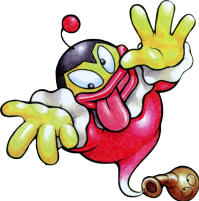
Other names: Bottle Demonlord (Japanese)
Dungeon: Bottle Grotto
Instrument: Conch Horn
- Broken Armor Boss Battle: He can only be attacked properly once Link has smashed his bottle by throwing it against the wall.
- Doppelgänger Spin: After his bottle is broken, Genie will create an illusory copy to circle the room with him before throwing fireballs.
- Dub Name Change: It's called Tsubo Maō, "Bottle Demonlord" in Japanese.
- Genie in a Bottle: He emerges from a clay bottle, which needs to be shattered before he can be harmed.
- Playing with Fire: Genie's main form of attack is to juggle fireballs then throwing them at Link.
- Shed Armor, Gain Speed: Genie is a lot more mobile when its bottle is destroyed, however, the bottle is its only means of protection, so...
- Shows Damage: The Genie's bottle cracks as it is thrown against the wall in the first phase. His lips and tongue change from red to purple as he takes damage in the second phase.
- Turns Red: Becomes more dangerous and angry after his bottle is broken, but can be shut down with well-timed spin attacks.
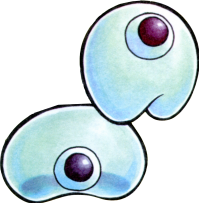
Other names: Big Zol (Japanese)
Dungeon: Key Cavern
Instrument: Sea Lily's Bell
The Nightmare of the Key Cavern that guards the Sea Lily's Bell.
- Behind the Black: Slime eye is invisible at first, and taunts Link over his inability to see him. He's on the ceiling, and would be quite visible from anything else but a top-down perspective.
- Ramming Always Works: Rushing into a wall with the Pegasus Boots causes Slime Eye to fall from the ceiling. Another couple of Dash Attacks is required to divide Slime Eye and make it vulnerable.
- Zerg Rush: Until Link can figure out how to have Slime Eye reveal itself, the Nightmare will send endless waves of Zol his way.
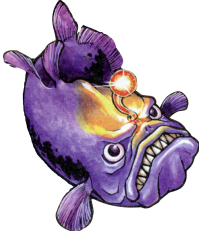
Other names: Angler (Japanese)
Dungeon: Angler's Tunnel
Instrument: Surf Harp
- Attack Its Weak Point: Its glowing lure, which is the only part of it that will take damage.
- Enemy Summoner: Smaller angler enemies swim across the screen to impede Link.
- Underwater Boss Battle: The rather limited mobility Link has underwater actually works to his advantage, allowing him to slash at the fish's weak point without worrying about positioning.

Other names: Hooker (Japanese)
Dungeon: Catfish's Maw
Instrument: Wind Marimba
- Attack Its Weak Point: It can only be damaged by attacking the body segment directly behind its head.
- Beware My Stinger Tail: Its tail ends in a giant flail that it swings in a circle around the arena.
- Dub Name Change: It's called Fukkā ("Hooker") in Japanese, alluding to the weapon you need to use.
- "Get Back Here!" Boss: Slime Eel spends most of its time hidden behind the walls. Link can only attack him by using the Hookshot to pull Slime Eel out of his hiding spot until its heart is exposed.
- Luck-Based Mission: As if snagging it with the hookshot while dodging the tail wasn't hard enough, there's a chance you'll pull out a decoy that will explode.
- Segmented Serpent: It resembles a long series of spherical segments, and its only weak spot is the one right behind its head.
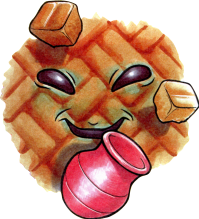
Other names: Matface (Japanese)
Dungeon: Face Shrine
Instrument: Coral Triangle
- The Computer Shall Taunt You: In the remake, if you fall into the pits Facade creates while fighting him, he'll laugh at you.
- Evil Laugh: It makes two of these in the Nintendo Switch remake: One when he says "Whoops! There I go, talking too much again..." and whenever Link falls into the abyss.
- Shows Damage: It starts the battle wearing a confident, sinister smile. When he goes below half health, his expression becomes more strained and his left eye begins to twitch.
- Small Role, Big Impact: Only exists as a boss in one dungeon, but it's the one that tells you about Koholint Island being a dream that will cease to exist once the Wind Fish wakes up.
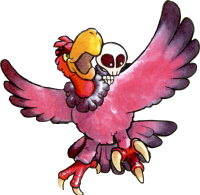
Dungeon: Eagle's Tower
Instrument: Organ of Evening Calm
The Nightmares of the Eagle's Tower that guard the Organ of Evening Calm.
- Anti-Frustration Features: In the Switch remake, falling from the arena due to Evil Eagle's Blow You Away attack will only land you on spikes and cause you to take damage instead of resetting the whole battle.
- Blow You Away: Evil Eagle will flap its wings to push Link off the platform, while also firing its feathers. The Mirror Shield can block both the wind as well as the projectiles.
- The Computer Shall Taunt You: In the remake, the Grim Creeper will laugh at you if you miss any of the bats he summons.
- Dub Name Change: The eagle is "Albatoss" in Japanese, one of many Mario references in this game. Grim Creeper is "Piccolo Player", which explains what he's doing in the mid-boss fight; the remake makes this aspect more apparent by adding the appropriate sound.
- "Get Back Here!" Boss: Evil Eagle spends most of its time offscreen as well as out of reach for most of Link's weapons.
- Giant Flyer: Evil Eagle is easily four times the size of Link.
- High-Altitude Battle: They're fought on the very top of their tower.
- Magic Music: As a counterpart to Link and his ocarina, Grim Creeper uses a piccolo to summon the bosses you fight.
- Never Say "Die": Grim Creeper refuses to acknowledge that you killed his bats.You k-k... beat my brothers!
- Platform Battle: In the original game, falling from the arena due to Evil Eagle's Blow You Away attack will reset the battle.
- The Unfought: Grim Creeper himself, technically. You only directly "beat" his brothers and the Evil Eagle, which somehow kills him as well.
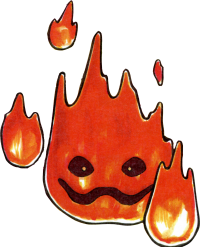
Other names: Big Flame (Japanese)
Dungeon: Turtle Rock
Instrument: Thunder Drum
The Nightmare of the Turtle Rock that guards the Thunder Drum.
- Glass Cannon: The Magic Rod stunlocks him, allowing you to beat rather easily. That said, a single blast of lava can do a whopping four hearts worth of damage (and your shield won't block it); if you then fall in the lava, you'll take even more damage. So don't let him hit you.
- Violation of Common Sense: How to beat a fire monster? Shoot it with your magic rod! You must literally fight fire with fire!
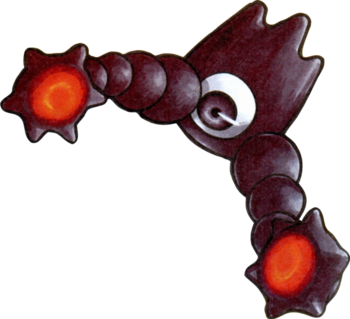
The last of the Nightmares to appear and shape-shifting Sequential Boss that has affected the dreams of the Wind Fish. In its battle with Link, it takes the forms of enemies Link has fought before.
- Alas, Poor Villain: For being an evil, living nightmare that wanted to take over the island and ensure that the Wind Fish never awakens, his last moments are him dying in despair, fully aware that everything is going to end.DethI: This island is going to disappear... our world is going to disappear... our world... our... world...
- Big Bad: Being the leader of the Nightmares and the Final Boss, DethI technically serves as this despite not being seen until the end.
- Boss Rush: It's a sequential boss whose forms are several bosses from A Link to the Past.
- But You Were There, and You, and You: As something of a Shout-Out, Vaati's One-Winged Angel form in The Minish Cap looks exactly like DethI. Bongo Bongo also bears a resemblance to DethI.
- Combo Platter Powers: This creature can shapeshift, use energy attacks, summon weapons and minions, and read its opponent's memories. All of this can be justified by the fact that it's living in a dream, and thus has some degree of control over reality in it.
- Contrasting Sequel Antagonist: Ganon was a mortal, if a cunning and dangerous one, while DethI is a true Eldritch Abomination. Ganon had full control over his avatar Agahnim and by extension the possessed soldiers, while DethI is content to let the other Nightmares and monsters do as they please. While Ganon was forced into the form of a demon boar, DethI has full control over its powers and can take on forms picked from Link's own mind. Finally, while both Ganon and DethI's defeats end up destroying a plane of existence, DethI's demise has a more somber feel to it.
- Devil's Pitchfork: While posing as Ganon, he attacks Link with a double-sided trident.
- Dub Name Change: "Death Eye" in Japanese; essentially the same, just spelled differently.
- Empathic Shapeshifter: The Nightmare takes the forms of enemies from Link's past, including Agahnim and Ganon.
- Faceless Eye: Its true form is a floating eye with arms that have spikes.
- Final Boss: This Nightmare and its forms is the last enemy blocking Link from waking the Wind Fish in Link's Awakening; its destruction allows Link to escape the island, but at the cost of its disappearance.
- Go for the Eye: Once the Nightmare goes through all the classic Zelda bosses in this fight, it shows its original true form as a giant eyeball with two spike arms. You have to attack its eye whenever it opens it to finish it off.
- Hijacked by Ganon: Inverted. Ganon appears during the final boss fight, but it's only a form taken by the Nightmare based on Link's memories of A Link to the Past.
- Never Say "Die": DethI was originally called "Death Eye". On the other hand, the phonics of its new name preserves the general impact and can be considered a Punny Name.
- One-Winged Angel: It warps through five or six different shapes in a last-ditch effort to beat Link, with the final one being particularly monstrous.
- The Problem with Pen Island: Its name's printing, which uses a sans-serif font, has resulted in many a player to think it was actually "Dethl" (small L), even though it's actually supposed to be "Death Eye". Even Zelda.com ended up getting this wrong.
- Red and Black and Evil All Over: DethI is pitch-black like the other shadows, but also has red paws on its hands.
- Sequential Boss: When the Nightmare is confronted at the end of the game, Link has to muscle his way though forms of previous Arch Enemies of his; the final form is an original monster and has the Mini-Boss theme over it.
- Tennis Boss: One of the forms it takes is Agahnim. You fight it the usual way.
- Villainous Breakdown: When it's defeated, it bemoans the imminent waking of the Wind Fish and the cessation of its own existence.
- Weaksauce Weakness: While it is admittedly the most powerful weapon in the game (to justify how hard it is to acquire), the Boomerang will destroy DethI in only one well-placed hit. The remake averts this.
Mini-Bosses

The Moblin leader who kidnapped BowWow, the pet Chain Chomp of Madam MeowMeow.
- Bullfight Boss: The boss battle involves leaping over the otherwise invulnerable Moblin Chief as he wildly charges Link, then striking him after he hits a wall.
- Bully Bulldog: A bulldog man who kidnaps a woman's beloved pet for some reason.
- Felony Misdemeanor: The Moblin Chief thinks Madam MeowMeow sent Link to assassinate him. While dognapping is pretty shady, it's not something punishable by death.Moblin Chief: You must be an assassin sent by Madam MeowMeow to rescue the mutt! You came here to get me, but it is I who will get you!!
- Furry Confusion: In this scenario, we have a anthropomorphic bulldog kidnapping an iron ball that acts like a dog!
- King Mook: Of the moblins, of course.
- Lone Wolf Boss: Unlike the rest of the bosses, the Moblin Chief lacks any humorous or self-aware dialogue, implying that he's not one of the Nightmares and is thus unaware that the island is inside a dream.
- Race Lift: Is a pig like all the other moblins in the remake.
A lumpy pink creature found in Tail Cave, which attacks by rolling a spiked bar at you.
- Adaptation Name Change: It was originally called "Rolling Bones".

A bomb-throwing cyclops. Three Hinoxes are fought in the game, in Bottle Grotto, Eagle's Tower and Turtle Rock.
- The Computer Shall Taunt You: In the remake, the hinoxes will laugh at you if they manage to grab you.
- Mad Bomber: Counters every hit you land on him with a throw of a bomb.
- Recurring Boss: Three distinct Hinoxes are fought in the game, each with the same tactics but colored a different shade.
- Throw the Mook at Them: If bombs don't work, he'll rush Link and throw him at the wall, posing the double threat of the damage from the throw with the potential threat of the cracked floors giving out under Link's weight, piling on further damage.

Item: Pegasus Boots
Two slug-like, big-mouthed creatures which crawl randomly around their room and swallow whatever's in front of their open mouths.
- Dual Boss: They're fought as pairs. Leave the room after defeating one, and a glitch will cause the other to disappear for an easy win.
- Feed It a Bomb: Like the regular Dodongos, they're beaten by placing bombs in front them when they're about to take a bite, which explode inside them once they're swallowed.
- Recurring Boss: Three pairs of Dodongo Snakes are fought in the game, once in Key Cavern, once in Face Shrine and once in Turtle Rock.
- You Don't Look Like You: The most abstract-looking of any Dodongo in the entire franchise.
Item: Angler Key
A centipede-like monster that lives in quicksand pit. Lanmola must be defeated to obtain the key that opens Angler's Tunnel.
- "Get Back Here!" Boss: It spends much of its time beneath the sand, blasting Link with projectiles when it emerges before hiding again.
- Heli-Critter: Its tail spins like a boat propeller, which aids it in both flying though the air and swimming through the sand.
- Malevolent Architecture: This boss fight takes place on a pit of quicksand, making the task of chasing Lanmola down to attack it significantly harder, walking uphill in every direction.
- Sand Worm: A giant, centipede-like monsters that swims within deep sand, emerging to attack.

A miniboss who runs around the room, and can only be harmed by striking its backside.
- Adaptation Name Change: Originally "Cue Ball", the remake's name is closer to the original.
- Attack Its Weak Point: Its front is heavily armored and impervious to attack, and it can only be damaged by attacking its voluminous backside.
- Chasing Your Tail: Running after it is one way to harm it, although it's easier to hit it as it rounds a corner or after jumping over with the Roc Feather
- Recurring Boss: Two Hydrosoars are fought, the first in a water-filled room in Angler's Tunnel and the second in a lava-filled one in Turtle Rock.
- Stealth Pun: Requires knowledge of its Japanese name: "Soar" is a synonym for "Hover" and also sounds like "Saur" as in "Helmasaur", which are Hiploops in Japanese.
Item: Hookshot
A stalfos who stole the Hookshot, and whom Link must chase around Catfish's Maw to get it back.
- Cowardly Boss: After four solid hits, he declares "I'm outta here!" and jumps out of the room. Link must find and defeat him four times before he goes down for good, dropping the Hookshot.
- Genre Blindness: He makes the mistake of stealing the dungeon's item, thus making it mandatory to find and kill him, no matter how much he flees.
- Inside Job: He's apparently the only enemy on Koholint to think to beat Link to the punch on acquiring the dungeon's treasure, stealing the Hookshot before Link can make his way through the dungeon.
- Know When to Fold 'Em: He acknowledges he can't beat Link and flees the battle. Doesn't do him a lick of good, lampshades that when before their last encounter he acknowledges You Can't Fight Fate and sees the battle through to the end, this time his permanent demise.

A pair of cyclopean monsters that guard the exit route in Catfish's Maw.
- Fireballs: At range, they attack by shooting fireballs from their eyes.
- Go for the Eye: They can only be harmed by shooting them in the eye, which can only be done when they open their eyelids to attack.
- Oculothorax: They resemble colossal eyeballs scuttling around on four jointed legs.
- Skippable Boss: They guard the Door to Before, but Master Stalfos has the item, and there's two routes to the boss.

A miniboss that guards the key to the Face Shrine within the in the Southern Face Shrine.
- Broken Armor Boss Battle: To defeat it, Link must use arrows or run into it to break off its armor, after which it will be possible to damage it with further arrows or regular sword strikes.
- Shockwave Stomp: It will periodically jump into the air and land with great force, stunning Link on impact unless he uses the Roc's Feather to jump into the air right as it lands.
- Took a Level in Badass: It does more damage than the Armos Knights in A Link to the Past.

A bizarre creature that totes an iron ball around and tries to throw it at you. One is fought in the Face Shrine, and a second in Turtle Rock. Different sources refer to this miniboss as either Smasher or Rover.
- Dub Name Change: It's called "Jacky" in the original Japanese.
- Recurring Boss: It's fought twice, in the Face Shrine and in Turtle Rock, with the same tactics and appearance.
- Respawning Enemies: Rover (Jacky) goes from being a boss battle to an annoyance later in the game. He respawns in Turtle Rock, forcing the player (who is probably lost in the firey labyrinth) to fight him again and again.
- Weaponized Ball: Smasher smashes with a huge metal sphere, roughly the same size as Link. Link needs the Level 2 Power Bracelet to pick it up and dish it back at him.
- Animate Inanimate Object: Ostensibly just a rocky statue built over Turtle Rock's entrance, Link uses the Frog's Song of Soul to breathe life into the statue, which can then be destroyed.
- Broken Armor Boss Battle: Its head is covered in rocky armor that Link can't pierce. Link must first use bombs to break off its shell, exposing a flesh head beneath that can be harmed with his regular weapons.
- Musical Nod: Has a unique theme song, which resembles the boss theme of A Link to the Past.
- Rock Monster: At first, requiring Link to bomb the rocky armor off. After this is removed, it becomes more vulnerable to his sword.
- Shows Damage: Its head armor will become visibly more cracked as it comes closer to shattering.
- Use Your Head: Since its head is the only part of its body that can move, it tries to kill Link by aggressively headbutting him. If it misses, it will hit the rocky walls around it and become stunned, leaving it vulnerable to attacks.
- Video Game Caring Potential: It is possible to enter the dungeon and spare the head. By charging into the entrance with the Pegasus Boots as the reanimated beast lunges, Link can enter the final level. While it doesn't softlock the game if Link goes back outside, sparing the head is incredibly difficult to execute, due to the quirky hitbox and collision detection.

A boxer whose punches will send Link to the beginning of the dungeon and who can only be damaged from behind, thanks to his excellent guarding technique.
- Barehanded Blade Block: Apparently his gloves are made of a stronger material than Link's sword.
- But You Were There, and You, and You: In-universe, he's seemingly based on the real Blaino Link fought in Oracle of Seasons.
- Circling Birdies: His lunge attack leaves Link seeing stars.
- Mook Bouncer: Get hit by his uppercut and it's back to start! In the Switch remake, his punches merely knock Link out of the room.
Other Characters
Mabe Village Residents
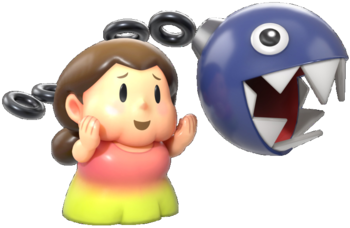
A villager who owns a trio of Chain Chomps.
- Fluffy Tamer: She owns three Chain Chomps, including BowWow, who gets kidnapped by the Moblins. Two are animalistic, but one, an apparently sapient one named CiaoCiao, lives in a doghouse and would rather accessorize than terrorize.
- Noblewoman's Laugh: The Switch version even gives her the associated pose.
- Smooch of Victory: When you return BowWow to her after finishing Bottle Grotto, she rewards Link with one of these, which also restores his health.
- Suspiciously Similar Substitute: Mamamu Yan is one of her, but in-universe it's the likely other way around.

Madam MeowMeow's beloved Chain Chomp, whom you must rescue from a band of moblins.
- Big Friendly Dog: Or Big Friendly Chain Chomp, but he certainly qualifies... unless you're an enemy. In the Switch version, after Link rescues and walks him, he'll even start reacting very happily to seeing him.
- A Dog Named "Dog": In Japanese. The Mario enemy called Chain Chomp in English is called Wan-Wan (basically "bark bark" or "bow-wow") in Japanese, so the big Chain Chomp is Wan-Wan the Wan-Wan. This is lost in the English version where he's BowWow the Chain Chomp, due to a translation that's inconsistent with the Mario games.
- Dub Name Change: In the German version, BowWow is named "Struppi" which is the German name given to Snowy. The Virtual Console version renamed him to "Komet".
- Eating the Enemy: Upon clearing the Moblin Cave and rescuing him, he'll devour any enemy you come across, including the Goponga Flowers blocking Bottle Grotto.
- Guest-Star Party Member: He briefly accompanies Link on his journey.
Four kids and their parents who live in Mabe Village.
- But Thou Must!: If you don't have the pineapple upon finding Papahl, your only options when he asks for help are "can't" and "nope".
- Character Catchphrase: "I'm just a kid."
- A Dog Named "Dog": In the original game, the father of the four boys is named Papahl. The Switch version takes this up to eleven by giving every family member a name that signifies their relationship: the mother is named Mamasha, and the four boys are Suhni (sonny), Lattie (laddie), Kidoh (kiddo), and Joonya (junior).
- Foreshadowing: They can't comprehend the idea of places outside the island, and can't recall the island's history because it's imaginary.
- He Knows About Timed Hits: The quadruplets will explain that select brings up the map, and A+B+Start+Select allows you to save. They don't exactly know what it means because they're "just kids".
- Just a Kid: The boys invoke this when they respond to Link after telling him a few important (and fourth wall breaking) things about the game, after which they comment that they don't actually know what these controls mean because they're just kids.
- Leaning on the Fourth Wall: Speaking to Papahl in the early game has him state outright that he’ll be lost in the hills later.
- Named by the Adaptation: Prior to the Switch version, only Papahl had a name.
- Running Gag: The four identical sons hang around Mabe Village and offer Link advice about the game mechanics. All of them end their statements with some variation of "I don't know what that means, I'm just a kid."
Animal Village Residents
- Half-Dressed Cartoon Animal: The animals who wear clothes tend to sport hats, shirts or aprons, and nothing else.
- Maurice Chevalier Accent: Schule the crocodile artist speaks in a tortured French accent of this sort, all "v" instead of "w" and "z" instead of "s" and "th".

A goat who lives in Animal Village, and who requires you to deliver a letter to Mr. Write on her behalf.
- Catfishing: She uses a photo of Princess Peach when writing love letters to Mr. Write, leaving him oblivious to the fact that she's actually a talking goat.
- Date My Avatar: She mailed Mr. Write her alleged photo, which is actually a photo of Princess Peach.
- Extreme Omnigoat: She eats the letters that Mr. Write sends her.
- Interspecies Romance: She's in a long-distance relationship with Mr. Write, a human.
- Tertiary Sexual Characteristics: You know she's a female goat chiefly because of the very large bow that she wears.

A peaceful Zora found in a water-filled house in the village.
- Palette Swap: It's distinguished from the regular, hostile ones by its teal body and purple fins and lips.
- Token Heroic Orc: It's a friendly River Zora who lives in Animal Village, where Link can find it after obtaining the Magnifying Lens. Link can even get a picture taken with him in DX, and a Secret Seashell in the Switch remake.
- Video Game Cruelty Potential: An accidental example. The GB version is an edited enemy sprite and still retains the coding for taking damage.
Other Island Residents

An over-excited shopkeeper in Koholint Prairie.
- Ascended Extra: A shopkeeper in this game, a main character in Captain Rainbow.
- Auto-Revive: The effect of her potions, which is carried over to the Oracle games but not with the rest of the franchise, is to revive Link at full health immediately when he goes down.
- Dub Name Change: The Japanese original calls her Whimsical Tracy, which fits her personality a little better. The French port calls her Monique la Lunatique for the rhyme.
- Informed Attribute: She doesn't really seem all that "crazy". It's probably a marketing gimmick.
- Insane Proprietor: Her English name of Crazy Tracy is an example of this marketing gimmick; her healing potion really is pretty crazy to be sold for such an affordable price.
- Intimate Healing: A mild example, she personally rubs her medicine onto Link when he buys it.
A giant sunfish in a cave next to the Angler's Tunnel. Teaches the player "Manbo's Mambo".
- Artistic License – Marine Biology: Is an ocean-based fish living in an ostensibly freshwater river.
- A Dog Named "Dog": Manbo is the Japanese name for his species, the "Mola Mola" ocean sunfish.
- Ambiguously Related: "Manbo's Pond" the default warp location for his song, is located right next to Crazy Tracy's house, but neither of them mention being affiliated with one another.
A singing frog hiding under the signpost maze. Teaches the player "Frog's Song of Soul".
- Adaptational Heroism: Was the Big Bad in Doki Doki Panic / Super Mario Bros. 2 but is an ally here.
- Inconsistent Dub: Uses his Japanese name rather than his English SMB 2 name of "Wart".
- Shout-Out: Is the villain from one of Nintendo's previous games, which incidentally also took place in a dream.

A gravedigger who runs the Chamber Dungeons. He only appears in the Switch remake.
- Canon Immigrant: He didn't appear in the original or DX versions of Link's Awakening, being added in the Switch remake. In fact Dampé wasn't even created until The Legend of Zelda: Ocarina of Time some five years after the original version of Link's Awakening.
- Legacy Character: He holds the distinction for being the only NPC in the game to be a recurring character in the franchise.

A ghost who haunts Link after Angler's Tunnel.
- Adaptational Badass: He was a warrior in the manga when he was alive.
- Composite Character: He's the one who gives Link the L-2 sword in the manga, combining his role with the Spirit of the Seashell Mansion.
- Death by Adaptation: While he was already technically "dead", in the manga he passes on completely, whereas the game had him stay at his grave permanently, apparently accepting it as his new home.
- The Load: He's too scared to enter any dungeons, and unlike Marin he's also too scared to just wait outside alone, so Link must get rid of him to progress.
- Named by the Adaptation: It's simply called "the Ghost" in the games, but is named Nakura in the manga.
- Our Ghosts Are Different: A vaguely blob-like, perpetually sad spirit of a deceased individual.
- Perpetual Frowner: His face is permanently set in a saddened frown.
- Video Game Cruelty Potential: At any time he's at his grave (as in, not following you), you can bother him by sprinkling magic powder on it. He threatens to put a curse on you, but never does.

A mermaid found in Martha's Bay, upset because she's lost her pearl necklace (or bikini top, depending on the version). She rewards Link with a scale from her tail if he returns it, which is necessary to complete the trading sequence.
- Bowdlerise: Her lost pearl necklace was originally a bikini top, and diving near her makes her call Link a pervert rather than tell him she's already searched the area. This is why the narrator seems embarrassed when you find the necklace. This change was originally specific to the US version, but it was applied to the European version for DX. The Switch version goes with the necklace in every region (understandably, given the update to full 3D models), and her reasoning for swimming away when you dive next to her is simply to keep Link from taking a scale before he retrieves the necklace.
- Hidden Depths: She apparently enjoys modeling, as she posed for Schule, who created a statue in her likeness. She stopped short of giving him a scale from her tail, leaving the statue incomplete.
- No Name Given: Her textbox simply calls her "Mermaid". While she inhabits Martha's Bay, she isn't the eponymous Martha.
- Our Mermaids Are Different: She's unique within the series because she's the only "classical" mermaid; the more famous sea Zora wouldn't be introduced until Ocarina of Time.
- Scenery Censor: She normally sits on a rock, but when she loses her top, she hides in the water to cover her bare chest. Doesn't apply in the versions where her missing item is a necklace, but she still hides in the water.
- Slippery Swimsuit: In the original version, her bikini top slipped off. A fisherman fishes it up under the bridge of Martha's Bay.

A lonely man who lives on the edge of the Mysterious Woods. He sends out letters day in and day out, but nobody ever replies.
- Catfishing: A victim of this. Christine, his long-distance partner/pen-pal has been sending him love letters with a picture of the human Princess Peach attached. She's actually a goat.
- Expy: He's one of Dr. Wright from the Super Nintendo port of SimCity, with whom he shares an identical appearance, theme music, and a homophonic name.
- Interspecies Romance: He's in a long-distance relationship with Christine, an anthropomorphic goat. The thing is, he doesn't actually know that she's a goat.
- Punny Name: His name is a pun on "Wright", the name of the character he's based on, and his obsessive writing habit.
- Adapted Out: He doesn't appear in the Switch remake and his house is replaced by Dampé's shack.
- Amazing Technicolor Wildlife: A big purple mouse.
- But Thou Must!: Refusing to let him take your picture results in him knocking you out and then taking the picture.
- What the Hell, Hero?: Captures the exact moment of you stealing from the Town Tool Shop.
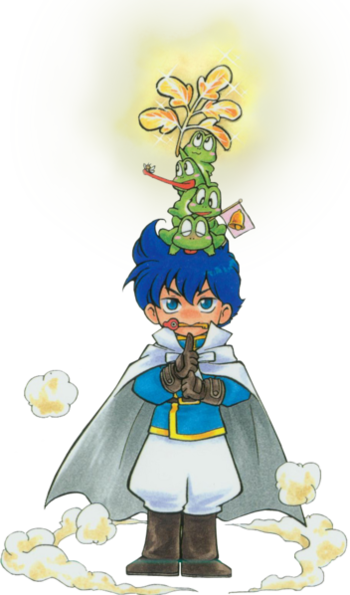
An exiled swordsman from Kanalet Castle. He asks Link to retrieve the five Golden Leaves that were left behind when he was forced to flee the castle, and gives him the Slime Key in reward when this task is completed.
- Crossover Cameo: He's The Rival from For the Frog the Bell Tolls.
- Fetch Quest: The errand he sends you on is to collect golden leaves from his castle.
- It's Up to You: He makes Link infiltrate the castle rather than do it himself.
- Permanently Missable Content: If you press the drawbridge switch before you get his picture, it will become permanently unavailable.
- Riddle for the Ages: It's never explained precisely why he wants those Golden Leaves so badly, or what he's going to do with them once he has them.
Manga Characters
- BFS: He has one, and it also serves as a deconstruction; he proves himself unable to draw the sword faster than Link can lunge at him.
- Bullying a Dragon: The only reason Karuna survived his first encounter with Link was because the hero's sword was broken. When Link returned with the sword of Nakura the ghost, he killed Karuna with a single blow.
- Eyepatch of Power: Over his left eye.
- King Mook: Is apparently one to the Pig Warrior Moblins.
- Single-Stroke Battle: Partakes in one with Link when they last meet, and he loses.
- Fairy Companion: To Link, filling in for the role Navi and Tatl played to other Links.






